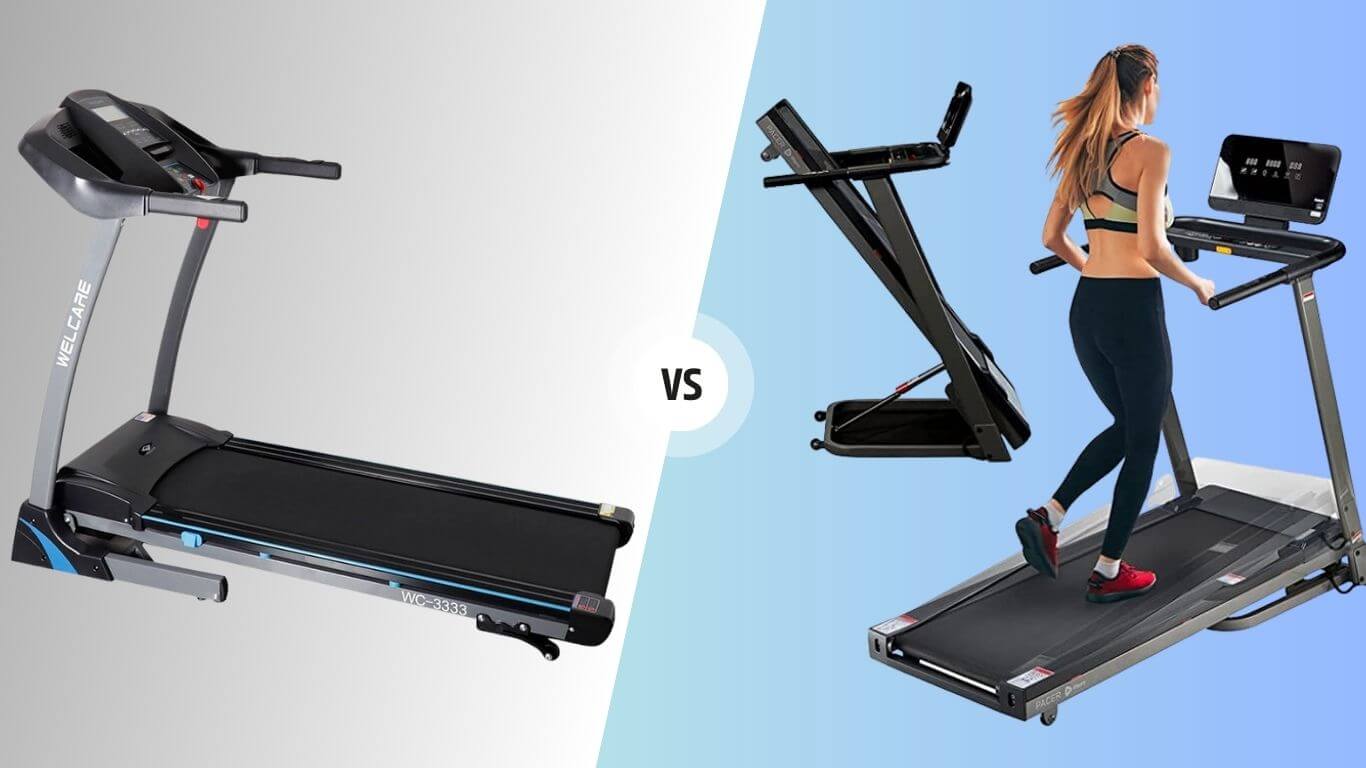Are you in pursuit of the perfect treadmill but torn between the allure of a foldable electric treadmill and the steadfast stability of a non-folding counterpart?
Look no further!
In this comprehensive guide, we delve into the age-old debate surrounding folding and non-folding treadmills, dissecting their features, benefits, and drawbacks to help you make an informed decision.
With limited space becoming a common challenge in modern homes, finding a fitness equipment solution that maximizes efficiency is paramount.
But are these foldable wonders worth the hype, or does the steadfastness of non-folding treadmills hold its ground?
By the end of this article, you will know and have insights to determine whether a foldable electric treadmill or a non-folding treadmill suits your fitness goals and lifestyle best.
What Is A Folding Treadmill?

A treadmill foldaway is an ingenious solution that brings versatility and space optimization to your home gym. Designed to accommodate those with limited space, a folding treadmill offers a practical and efficient exercise option.
When it comes to folding treadmills, their defining feature is in the name itself—they can be folded up, allowing for compact storage.
Equipped with transport wheels, these treadmills offer effortless maneuverability, making it a breeze to tuck them away when not in use.
Pros
- Efficient for limited space
- Increased portability
- Storage possibilities
- Easy to clean underneath
Cons
- Not as stable as a non-folding treadmill
What Is A Non-Folding Treadmill?

Non-folding treadmills represent the epitome of durability and stability in cardio fitness equipment.
These robust machines, available in both motorized and manual variants, are designed to remain stationary, catering to the demands of commercial settings and serious fitness enthusiasts.
Unlike their foldable counterparts, non-folding treadmills boast a solid, fixed structure emphasizing longevity and rigidity.
This sturdiness ensures optimal performance and minimizes the risk of unwanted vibrations during intense workouts.
However, this steadfast nature poses a challenge regarding relocation or storage, as disassembling the treadmill into manageable pieces requires considerable effort.
Pros
- Generally more stable than foldable units
- Typically have a higher user weight capacity
- Motorized options
Cons
- Usually more expensive
- Heavy
- Limited portability
Choosing Between A Folding Vs Non Folding Treadmill
Space
When optimizing space in your home gym, including a home treadmill folding option can be a game-changer. These collapsible treadmills are designed to cater to small spaces, making them an ideal choice for those with limited room.
Unlike their non-folding counterparts, which tend to have a larger footprint and occupy more space in your room, folding treadmills offer a convenient solution without compromising functionality.
Whether you are a fitness enthusiast or one of the Treadmill Workouts For Obese Beginners, the compact design of a folding treadmill ensures that you can achieve your fitness goals without sacrificing valuable space within your home.
Storage Needs
Regarding storage needs, the convenience of a foldable treadmill becomes a key consideration.
For those with limited space or a multifunctional room, the ability to quickly transform your exercise area into a playroom or accommodate dinner guests is invaluable. With fold-up treadmills, storage becomes a breeze.
Most foldable units are equipped with wheels, enabling effortless folding and easy maneuverability.
Simply fold up the treadmill, wheel it away, and regain the space for other activities. If you tidy up any sweat, your guests won’t even suspect your living room was recently transformed into a dynamic workout zone.
Portability
Regarding portability, choosing between a foldable treadmill and a non-folding model can significantly impact your convenience and mobility.
With foldable treadmills equipped with practical wheels, transporting them from one location to another becomes a breeze.
Whether you prefer a change of scenery during your workout or need to create additional space in your home, effortlessly moving a foldable electric treadmill is a valuable asset.
On the other hand, non-folding treadmills often boast a substantial weight, contributing to their sturdy construction.
Motor Size
Non-folding treadmills, such as the Soozier folding electric treadmill, often boast larger motors, enabling them to accommodate heavier user weights while delivering a seamless and consistent workout experience.
The treadmill’s continuous horsepower (CHP) is a reliable metric for assessing motor power.
This measurement provides valuable insights into the motor’s sustained output capability, ensuring optimal performance during intense workouts.
However, it’s important to note that if you opt for a manual treadmill, you can generate the motor power yourself.
Safety
Safety is paramount when selecting a treadmill, whether it’s a folding treadmill for home use or a non-folding model. While both types require standard safety measures, folding treadmills necessitate extra caution in a residential setting.
When the treadmill is folded up, it is imperative to ensure that the safety locks are securely engaged, preventing any accidental deck collapse that could potentially cause harm, particularly to small children and pets.
Moreover, for older adults seeking enhanced safety, features such as side handles, a lower deck height, and streamlined controls can prove beneficial.
Extras
However, it’s not just about the basic functionality; the extras elevate your workout experience.
Embracing modernity, treadmills now offer myriad features to enhance your training sessions. Picture a vibrant touch screen displaying immersive workout programs by certified trainers effortlessly streamed through platforms like iFIT or the Peloton app.
Such interactive programming caters to beginners seeking guidance and invigorates seasoned runners with exciting challenges.
But that’s not all – heart rate monitors, adjustable deck cushioning, and even automatic trainer control are among the enticing extras that can take your fitness journey to new heights.
Weight Capacity
The innovative convenience of an easy-fold treadmill often comes at a trade-off – a compromise in overall sturdiness. Due to their foldable nature, these models tend to have a more limited weight capacity, catering to individuals within a specific range.
On the other hand, non-folding treadmills, while lacking the portability of their foldable counterparts, excel in stability, offering increased weight capacity for users of various sizes and body types.
Deck Length
The length of the treadmill’s deck determines the running surface available to you, directly impacting your comfort and performance.
Treadmill collapsible options often offer suitable deck sizes, but it’s worth noting that non-folding treadmills generally boast longer deck lengths and broader belts.
These specifications cater to the needs of taller athletes and avid runners who desire unhindered movement and the freedom to push their limits.
While a 60-inch deck is considered ideal for runners, extra deck length may not be as paramount if your intended usage revolves around walking.
Frequently Asked Questions
Wrapping Up!
When it comes to choosing between a folding and non-folding treadmill, it ultimately depends on your specific needs and circumstances.
Folding treadmills offer space-saving convenience, making them ideal for those with limited room or who prefer easy storage. On the other hand, non-folding treadmills are typically sturdier and more durable, making them suitable for intense workouts and heavy usage.
Before deciding, it’s essential to consider factors such as available space, usage frequency, and personal preferences.
So, which treadmill type aligns better with your fitness goals and lifestyle? Are you prioritizing space-saving features or seeking maximum durability and stability?



